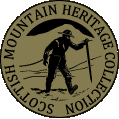
The Scottish Mountain Heritage Collection
Objects Database
Rock Climbing Waistbelts (early versions)
Accession Number
1625.2021.1(a-c)
Object Name
Rock Climbing Waistbelts (early versions)
Created
24/08/2021
Creator
Hermione Cooper
Accession Date
24/08/2021
Brief Description
Three climbing webbing waistbelts with metal buckles.
Materials
nylon webbing, metal
Dimensions
a-92(L) x 5(W) b- 112(L) x 4.5(W) c- 140(L) x 5(W) cms
Number Of Objects
3
Inscription Description
ON b handwritten in ink "GLENMORE LODGE NO9"
Colour
a- orange b- yellow c- grey
Provenance
It took mountaineers a 100 years or so to realise that falling off was pretty miserable, especially if you fell with a single strand of rope tied round your waist.
The epic attempts of Toni Kurz and his companions on the North face of the Eiger in 1936 illustrated the technique rather cruelly since two of the party, at least, died of asphyxiation with the rope restricting movement of the diaphragm.
To help alleviate the problem, climbers started wrapping several strands of rope around their waists to spread the load. Then along came waistbelts (circa 1960), three early versions of which we have here in the collection.
The bottom one is part of an Irvine parachute harness which ultimately became one of MOAC’s early commercial products - there’s a branded version elsewhere in the collection.
The yellow one has a parachute harness buckle grafted onto the same early, wide webbing and was issued to Glenmore Lodge students in the 1970’s.
The orange one is a fairly scary affair of the homemade variety, sporting a dodgy buckle and some holes burnt in to attach gear loops.
Fortunately, progress ensured much better waist, chest and full body harnesses so you can relax next time you fall off the Eiger!
Acquisition Date
24/08/2021
Condition Check Date
24/08/2021
Rules
Spectrum : UK Museum documentation standard, V.3.1 2007
Modified
24/08/2021
